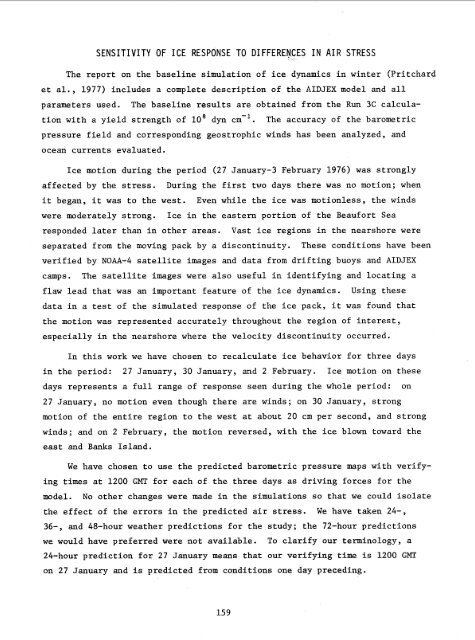AIDJEX Bulletin #40 - Polar Science Center - University of Washington
AIDJEX Bulletin #40 - Polar Science Center - University of Washington
AIDJEX Bulletin #40 - Polar Science Center - University of Washington
You also want an ePaper? Increase the reach of your titles
YUMPU automatically turns print PDFs into web optimized ePapers that Google loves.
SENSITIVITY OF ICE RESPONSE TO DIFFERENCES IN AIR STRESS<br />
The report on the baseline simulation <strong>of</strong> ice dynamics in winter (Pritchard<br />
et al., 1977) includes a complete description <strong>of</strong> the <strong>AIDJEX</strong> model and all<br />
parameters used. The baseline results are obtained from the Run 3C calculation<br />
with a yield strength <strong>of</strong> 10' dyn cm-'. The accuracy <strong>of</strong> the barometric<br />
pressure field and corresponding geostrophic winds has been analyzed, and<br />
ocean currents evaluated.<br />
Ice motion during the period (27 January-3 February 1976) was strongly<br />
affected by the stress. During the first two days there was no motion; when<br />
it began, it was to the west. Even while the ice was motionless, the winds<br />
were moderately strong. Ice in the eastern portion <strong>of</strong> the Beaufort Sea<br />
responded later than in other areas. Vast ice regions in the nearshore were<br />
separated from the moving pack by a discontinuity. These conditions have been<br />
verified by NOAA-4 satellite images and data from drifting buoys and <strong>AIDJEX</strong><br />
camps. The satellite images were also useful in identifying and locating a<br />
flaw lead that was an important feature <strong>of</strong> the ice dynamics. Using these<br />
data in a test <strong>of</strong> the simulated response <strong>of</strong> the ice pack, it was found that<br />
the motion was represented accurately throughout the region <strong>of</strong> interest,<br />
especially in the nearshore where the velocity discontinuity occurred.<br />
In this work we have chosen to recalculate ice behavior for three days<br />
in the period: 27 January, 30 January, and 2 February. Ice motion on these<br />
days represents a full range <strong>of</strong> response seen during the whole period: on<br />
27 January, no motion even though there are winds; on 30 January, strong<br />
motion <strong>of</strong> the entire region to the west at about 20 cm per second, and strong<br />
winds; and on 2 February, the motion reversed, with the ice blown toward the<br />
east and Banks Island.<br />
We have chosen to use the predicted barometric pressure maps with verifying<br />
times at 1200 GMT for each <strong>of</strong> the three days as driving forces for the<br />
model. No other changes were made in the simulations so that we could isolate<br />
the effect <strong>of</strong> the errors in the predicted air stress. We have taken 24-,<br />
36-, and 48-hour weather predictions for the study; the 72-hour predictions<br />
we would have preferred were not available. To clarify our terminology, a<br />
24-hour prediction for 27 January means that our verifying time is 1200 GMT<br />
on 27 January and is predicted from conditions one day preceding.<br />
15 9








